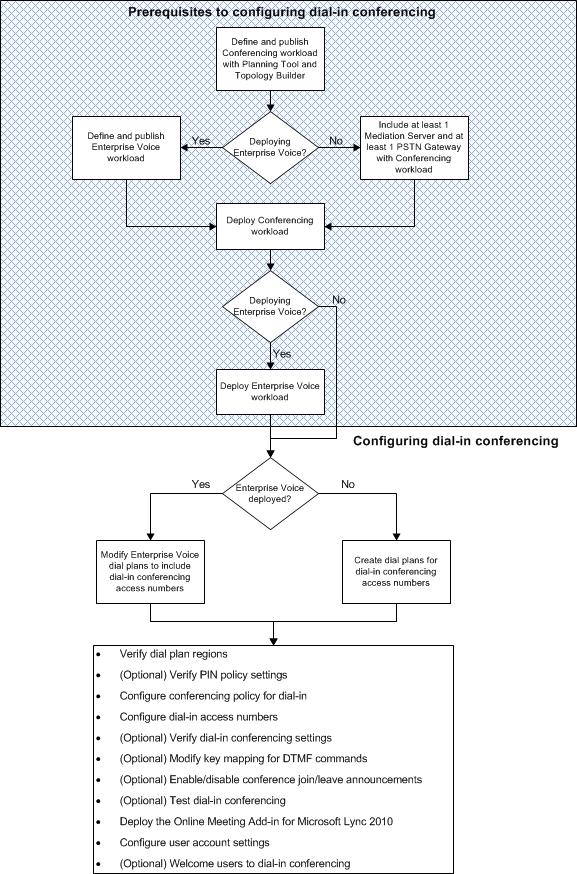Topic Last Modified: 2011-01-25
Dial-in conferencing is an optional component of the Microsoft Lync Server 2010 Conferencing workload. The components you need to install before you can configure dial-in conferencing are deployed when you use the Microsoft Lync Server 2010, Planning Tool and Topology Builder to design your topology and then set up your Front End pool or Standard Edition server. This topic describes what you need to have accomplished before you can configure dial-in conferencing.
This section assumes that you have read the planning sections related to the Conferencing workload and dial-in conferencing in particular.
 Dial-in Conferencing
Configuration Prerequisites
Dial-in Conferencing
Configuration Prerequisites
Dial-in conferencing requires the following Lync Server 2010 components:
- Unified Communications Application Service (UCAS) (called the
Application service)
- Conferencing Attendant application
- Conferencing Announcement application
- Dial-in Conferencing Settings webpage
- At least one Lync Server 2010 Mediation Server and at least one
PSTN gateway
You deploy these components when you use the Lync Server 2010, Planning Tool and Topology Builder to define and publish your topology and then deploy a Front End pool or a Standard Edition server. If you are deploying Enterprise Voice, you should deploy it before you configure dial-in conferencing. If you are not deploying Enterprise Voice, you can deploy a Mediation Server and a public switched telephone network (PSTN) gateway when you deploy your Front End pool or Standard Edition server.
 Note: Note: |
|---|
| If you are upgrading from Office Communications Server 2007 R2 to Lync Server 2010, deploy dial-in conferencing in every pool that you plan to use to host Lync Server 2010 conferences. For details about migrating dial-in conferencing, see Migration from Office Communications Server 2007 R2 to Lync Server 2010. |
This section assumes that you have done the following:
- Applied at least Cumulative Update 5 (CU5) to your Office
Communications Server 2007 R2 environment, if you are migrating to
Lync Server 2010. For the most up-to-date information about Office
Communications Server 2007 R2 updates, see "Updates Resource Center
for Office Communications Server 2007 R2 and Clients" at http://go.microsoft.com/fwlink/?LinkId=199488.
- Used the Planning Tool and Topology Builder to design and
configure your topology. While specifying the Conferencing
workload, you selected the dial-in conferencing option. For details
about defining your topology, see Defining the Topology in
Topology Builder in the Deployment documentation.
- Published your topology, and set up the Front End pool or
Standard Edition server. For details about publishing the topology
and installing Lync Server 2010, see Deploying Lync Server
2010 Enterprise Edition in the Deployment documentation.
 Note:
Note:When you install your published topology, the Dial-in Conferencing Settings webpage is installed on the Front End Server or Standard Edition server as part of Web Services.  Important:
Important:If you change the path for the File Store in Topology Builder after you deploy Lync Server 2010, you need to restart the Conferencing Attendant and Conferencing Announcement applications to use the new path. - Deployed Enterprise Voice. If you are not deploying Enterprise
Voice, you either collocated a Mediation Server on the Enterprise
Edition Front End Server or the Standard Edition server, or you
deployed a stand-alone Mediation Server, and you deployed a PSTN
gateway. For details about deploying Enterprise Voice, see Deploying Enterprise
Voice in the Deployment documentation. For details about
installing a stand-alone Mediation Server and PSTN gateway, see
Deploying
Mediation Servers and Defining Peers in the Deployment
documentation.
The following flowchart shows the steps that you must perform before you can configure dial-in conferencing and the steps that you perform to configure dial-in conferencing.

 Dial-in Conferencing
Permissions
Dial-in Conferencing
Permissions
To configure dial-in conferencing, you need to use the following administrative tools:
- Microsoft Lync Server 2010 Control Panel
- Lync Server Management Shell
You use these administrative tools to configure dial-in conferencing settings, and the dial plans, policies, and other settings that dial-in conferencing requires.
Configuring dial-in conferencing requires any of the following administrative roles, depending on the task:
- CsVoiceAdministrator This administrator
role can create, configure, and manage voice-related settings and
policies.
- CsUserAdministrator This administrator
role can enable and disable users for Lync Server and assign
existing policies, such as conferencing policies and PIN policies,
to users.
- CsAdministrator This administrator role
can perform all of the tasks of CsVoiceAdministrator and
CsUserAdministrator.
 See Also
See Also
Concepts
Deploying Enterprise VoiceOther Resources
Dial-In Conferencing in Lync Server 2010Deploying Lync Server 2010 Enterprise Edition
 See Also
See Also
